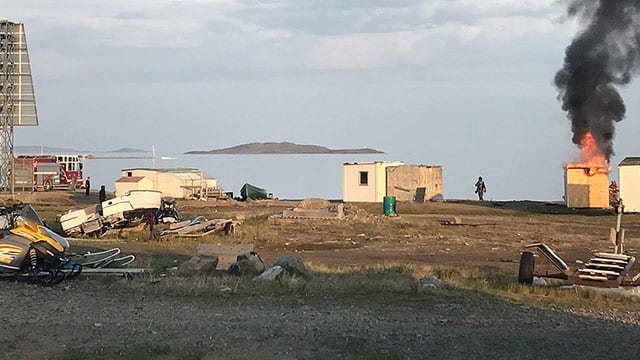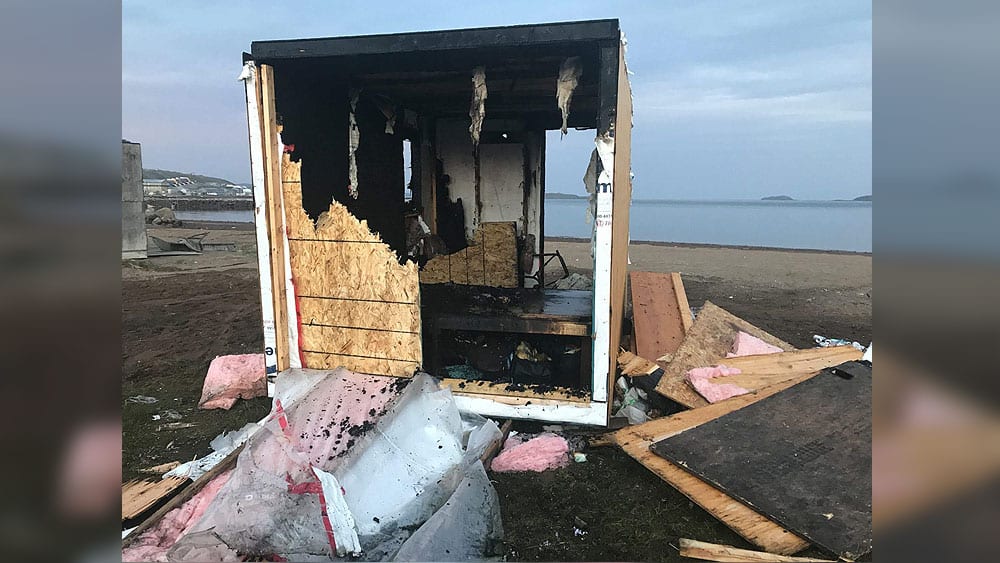
This wooden shack caught fire on an Iqaluit beach on July 19. {Submitted photo.)
(Firefighters tackle a shack fire on the shore of Frobisher Bay in Iqaluit on July 19. Photo courtesy: Qaumariaq Inuqtaqau)
A war of words has erupted on social media about how many people are homeless in the Nunavut capital of Iqaluit.
Inuit activist Qaumariaq Inuqtaqau claims at least 100 people are living in wooden shacks, nylon tents, old boats and unused cars in and around the city of about 7,000.
“I find out about more shacks and homeless all the time,” Inuqtaqau said.
“People are at Apex (the outskirts), the causeway, in old cars and tents in residential areas, and the beach, as well.”
But Mayor Madeleine Redfern questions that number.
“You have to substantiate it,” she told APTN News on Twitter after it reported Inuqtaqau’s figure last week.
The two have been going back and forth online since a shack used by a homeless family caught fire when.
No one was injured.
Inuqtaqau said it’s the third fire to affect the homeless population, whom he advocates for on his Facebook page and by delivering food and clothing donated from people living in southern Canada.
He said people are usually homeless because they can’t afford or find housing. He said “couch surfing” with friends and relatives is common until one or both parties need a break.
(This homeless shack was insulated before being destroyed by fire in Iqaluit earlier this summer. Photo courtesy: Qaumariaq Inuqtaqau)
Iqaluit has shelters for men and women but couples aren’t allowed so Inuqtaqau says they live in tiny shacks on the shore of Frobisher Bay.
Sometimes people end up on the street because their home is over-crowded, he added.
“Living homeless in an old boat is simply unacceptable. Nobody deserves to be living this way,” he said.
“Something has to be done now. More shelters, temporary tiny houses, more jobs, more housing.”
He showed APTN Investigates some of these wooden shacks in 2016, which don’t have heat, electricity or plumbing. Several were home to people who work full-time but can’t afford to rent a two-bedroom apartment for more than $2,000 a month.
Camping stoves are used to heat the shacks when it’s cold and that can spark fires.
Redfern visited the family that lost their shack after last week’s blaze and says they received supplies from the Red Cross and social services.
She advised them to put their names on a list for housing as people with children move to the front of the line.
But Inuqtaqau questioned her commitment after city workers hauled away a shack, some tents and an old boat after the fire, in an effort to clear the area of flammable items.
“Taking away the last possessions from people that have next to nothing,” he said, noting he’s frustrated with what he sees is a lack of action on homelessness.
The mayor says not one person or government is responsible for finding solutions.
“It does not fall on any single level of government and, if anything, the city has taken a lead in facilitating the work,” she said of a major expansion planned for Uqutaaq, the men’s shelter if funding comes through.
Uqutaaq would relocate to two buildings with 60 beds and programming space from a four-bedroom house that has provided shelter for up to 50 men.
“Part of the reason why we’ve been able to get to the stage that we’re at…is because all three levels of government have worked together,” Redfern noted.
“The Inuit organizations have assisted and provided a funding contribution. We are now also meeting with and seeking some support of key corporate donors.”
Redfern doesn’t know how many people are homeless in her city but says the government of Nunavut (GN) will soon start counting them as part of a territory-wide census.
(Couples aren’t allowed in the men’s or women’s homeless shelters in Iqaluit so some live in unheated sheds. Photo courtesy: Qaumariaq Inuqtaqau)
A similar homelessness count was tried in 2014 but considered incomplete.
“We need to ensure that it’s not just what is termed ‘absolute homelessness’ counting the people who are staying at the shelter or the small number of people on the beach,” she said in a telephone interview.
“But that the larger problem is all the people who are living in overcrowded housing with family or friends for years.”
Redfern, who is also president of the Nunavut Association of Municipalities (NAM), knows the need for more housing is great and growing throughout the territory.
She’s said NAM has sent resolutions to other levels of government indicating the lack of housing “is a barrier” to hiring Inuit.
As a result, she said the GN is planning to build more social housing in Iqaluit and transitional housing throughout the territory.
“There’s a very low vacancy rate in Iqaluit and the rents in the private sector are very expensive – when and if you’re able to get a unit,” she says.













